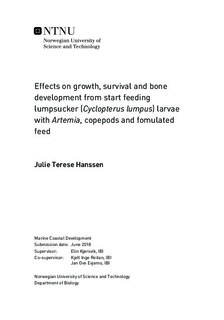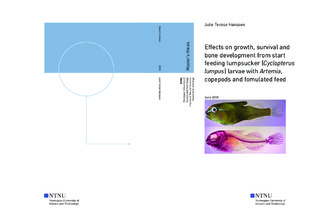| dc.description.abstract | Salmon lice (Lepeoptherius solmonis) is a major health problem in salmon (Salmo salar) production. Reduced lice sensitivity towards several of the chemical treatments have increased the interest in cleaner fish used to biological remove salmon lice. The cleaner fish, lumpsucker (Cyclopterus lumpus) is a relatively new aquaculture species and there is little knowledge about the optimal rearing conditions, nutrition and the skeletal development.
The aim of this study was to describe the skeletal development in lumpsucker (C. lumpus) and to evaluate growth, survival and skeletal development in larvae fed with three different diets; Artemia, copepods (A. tonsa) and formulated feed. One group was fed enriched Artemia, a second group fed copepods and the third group was fed a combination of A. tonsa (2-9 dph) and formulated feed (from 7 dph). At 20 dph all groups were weaned to formulated feed and fed it exclusively from 22-51 dph.
Start feeding with Artemia improved larval growth and survival compared to larvae fed copepods and formulated feed. The dry weight, wet weight and standard length were significantly higher already from 6 dph and throughout the experiment. Newly hatched larvae had bone ossification in mouthparts, cleihtrum, vertebrae and suction disc. Earlier onset of skeletal ossification related to age was observed in larvae fed Artemia. Significantly more vertebrae were fully ossified from 10-50 dph and more larvae had ossified pterygiophores of first dorsal and anal fins at 42 dph. In addition, at 21 dph significantly more tail fin rays had ossified. However, the larvae fed copepods had ossification in vertebrae, dorsal, anal and tail fins, urostyle and hypurals at a smaller size. The smallest larva with 80-90 % fully ossified vertebrae was 9.9 mm, over 0,8 mm shorter than larvae fed Artemia and formulated feed. The pterygiophores were ossified in larvae fed copepods larger than 8.3 mm, compared to 9,0 and 8,8 mm for larvae fed Artemia and formulated feed. The occurrence of severe skeletal anomalies (flat skull and axis deviations) were 1 % at 50 dph. Fusion of two vertebrae were found in less than 11 % of all larvae at 50 dph. Twisted neural arches, a small abbreviation from the normal form was observed in significantly more larvae fed formulated feed. The occurrence was highest in younger larvae and considerably lower at 50 dph. | |

